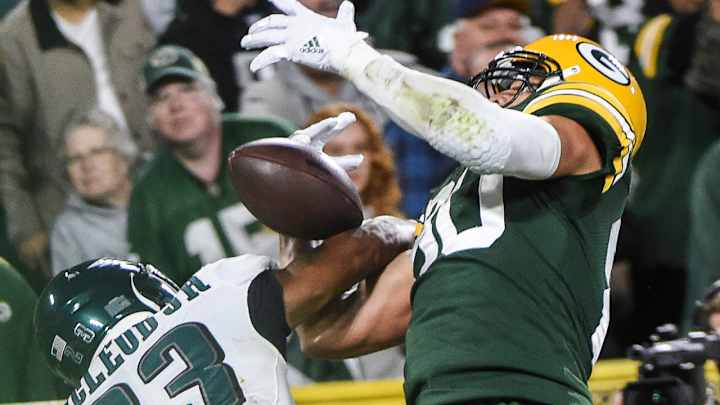Fundamental flaw dooms first goal-to-go series

For all the consternation over the defense’s prime-time disappearance, missed pass-interference penalties, the failed run-pass option on third-and-goal and the end zone interception that ended the game, the Green Bay Packers might have been 4-0 had one of the best tight ends in NFL history made a fundamental play.
The Eagles took a 34-27 lead with 14:13 remaining on Jordan Howard’s second touchdown of the game. Green Bay took possession at its 21 on the ensuing kickoff but quickly moved into scoring range with a 14-yard scramble by Aaron Rodgers, three completions to running back Aaron Jones rewarding the team with 35 yards, and a 13-yard completion to Davante Adams making it first-and-goal at the 8. An interference penalty a couple plays later made it first-and-goal at the 1.
LaFleur video: Got to hit the reset button.
On first down, the Packers lined up with Jimmy Graham, Marcedes Lewis and guard Lucas Patrick as tight ends and fullback Danny Vitale and running back Aaron Jones in an “I” formation. Before the snap, Lewis and Graham split out wide. Rodgers threw a fade to Graham, who couldn’t make a one-handed grab while jostling with safety Rodney McLeod.
On second down, the Packers kept the same personnel, with Graham and Lewis staying in as tight ends rather than motioning outside. The call was a bootleg, with run action to the left and Rodgers rolling out to the right. Eagles defensive end Brandon Graham wasn’t fooled, though. He didn’t bite on the fake and made a bee line at Rodgers, who threw the ball at Vitale’s feet for an intentional incompletion.
On third down, LaFleur changed personnel, with Graham wide left, receiver Allen Lazard in the left slot, receiver Geronimo Allison in the right slot and receiver Marquez Valdes-Scantling wide right and Jones to Rodgers’ left. It was a run-pass option, and it didn’t work.
Down a touchdown, coach Matt LaFleur kept his offense on the field. Using the same personnel as on third down, the Packers went tempo, with the offense sprinting to the line and quick-snapping the ball. Lazard, Allison and Valdes-Scantling were in a bunch to the left, Graham was the only target on the right and Jones aligned to Rodgers’ right. With nobody open, Rodgers extended the play to the right. Still, nobody was open. With defensive tackle Fletcher Cox applying late pressure, Rodgers threw a high ball in the back of the end zone to Graham, who was covered tightly by linebacker Zach Brown. Graham went up with one hand to make the catch but couldn’t haul it in.
That was the fundamental flaw. Unlike the first-and-goal play, with Graham and McLeod engaging in hand-fighting in the end zone, Graham eschewed the type of fundamental play he’s made throughout a sterling career.
“He’s well aware that he should have went up with two (hands),” tight ends coach Justin Outten confirmed. “The one before that, it was a combative situation so that was understandable, but he’s well aware that he should have gone up with two on the last one.”
Graham had been held without a catch in each of the previous two games. Against the Eagles, he caught six passes for 61 yards and one touchdown. He might have been the hero had he gone up with two hands for a second touchdown.
“He’s a true competitor and a true competitor obviously wants to have a big part in helping the team win,” Outten said of Graham’s mind-set before the game. “He was a little frustrated going into this game. It was our job to get him the ball. In previous weeks, when you have him as the first look and first read, sometimes the defense has other plans. Certain situations the last couple weeks against good defenses, they took away some of those situations. It was good to see him get rolling yesterday.”
